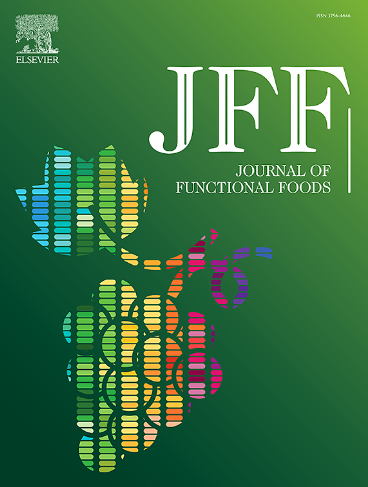比较鼠李糖乳杆菌 GG 和 luxS 突变体对受到大肠杆菌挑战的小鼠肠道屏障功能的影响
IF 3.8
2区 农林科学
Q2 FOOD SCIENCE & TECHNOLOGY
引用次数: 0
摘要
群体感应(QS)是细菌通过自诱导剂(AIs)进行交流的重要途径。已证实参与QS的luxS基因可调控鼠李糖乳杆菌GG (LGG)的不同行为,而AI-2/ luxS系统是否通过调控LGG对宿主产生有益影响尚不清楚。我们的目的是研究luxS突变是否影响LGG维持大肠杆菌感染小鼠肠道微生物群稳态、肠道屏障完整性和炎症免疫反应的能力。本研究表明,LGG野生型(WT)和luxS突变体(ΔluxS)均可通过下调拟氏菌的相对丰度来缓解大肠杆菌引起的菌群变化。添加WT和ΔluxS可提高脾脏CD4+/CD8+比值,增加杯状细胞数量,促进Muc 2分泌。此外,WT和ΔluxS通过抑制MAPK和NF-κB信号转导降低促炎介质水平。本文章由计算机程序翻译,如有差异,请以英文原文为准。

Comparison of Lactobacillus rhamnosus GG and luxS mutant on gut barrier function of mice challenged with Escherichia coli
Quorum sensing (QS) is an essential pathway for bacterial communication through autoinducers (AIs). The luxS gene involved in QS has been proven to regulate different behavior of Lactobacillus rhamnosus GG (LGG), whereas it is unclear whether the AI-2/LuxS system have beneficial effects the host by regulating LGG. Our aim was to investigate whether luxS mutation affects the ability of LGG to maintain intestinal microbiota homeostasis, intestinal barrier integrity and inflammatory immune responses in mice infected with Escherichia coli (E. coli). This study showed that both wild-type (WT) and luxS mutant (ΔluxS) of LGG can alleviate changes in the microbiota caused by E. coli by down-regulating the relative abundance of Parasturtella. Supplementation with WT and ΔluxS increased the CD4+/CD8+ ratio in spleen, improved goblet cell numbers and enhanced Muc 2 secretion. Moreover, WT and ΔluxS decreases proinflammatory mediator levels by inhibiting MAPK and NF-κB signal transduction.
求助全文
通过发布文献求助,成功后即可免费获取论文全文。
去求助
来源期刊

Journal of Functional Foods
FOOD SCIENCE & TECHNOLOGY-
CiteScore
9.60
自引率
1.80%
发文量
428
审稿时长
76 days
期刊介绍:
Journal of Functional Foods continues with the same aims and scope, editorial team, submission system and rigorous peer review. We give authors the possibility to publish their top-quality papers in a well-established leading journal in the food and nutrition fields. The Journal will keep its rigorous criteria to screen high impact research addressing relevant scientific topics and performed by sound methodologies.
The Journal of Functional Foods aims to bring together the results of fundamental and applied research into healthy foods and biologically active food ingredients.
The Journal is centered in the specific area at the boundaries among food technology, nutrition and health welcoming papers having a good interdisciplinary approach. The Journal will cover the fields of plant bioactives; dietary fibre, probiotics; functional lipids; bioactive peptides; vitamins, minerals and botanicals and other dietary supplements. Nutritional and technological aspects related to the development of functional foods and beverages are of core interest to the journal. Experimental works dealing with food digestion, bioavailability of food bioactives and on the mechanisms by which foods and their components are able to modulate physiological parameters connected with disease prevention are of particular interest as well as those dealing with personalized nutrition and nutritional needs in pathological subjects.
 求助内容:
求助内容: 应助结果提醒方式:
应助结果提醒方式:


